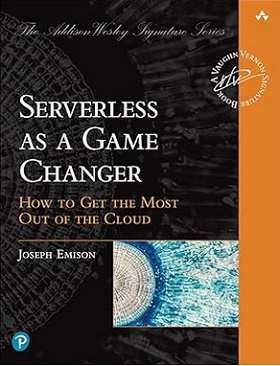| Serverless As A Game Changer (Pearson) |
|
Author: Joe Emison This book is subtitled 'how to get the most out of the cloud', and it sets out the decisions that need to be made by companies thinking about a move to running their business on cloud environments. Emison's premise is that instead of thinking in terms of building apps for the cloud, you need to start from a higher level, decide whether your tech stack is optimized, whether you can buy existing apps instead of building, and choose the right services. As such, the book is aimed at business executives rather than developers. Emison starts with a section titled 'the serverless mindset'. The message he wants to get across is that cloud software is still improving, but many companies haven't adopted it efficiently. He sets out a useful analysis of the real cost of software development, splitting it into different types of cost - direct, opportunity, indirect, fixed, variable, and sunk costs. Given the sector's history of spectacular failed projects, this is probably something most managers and directors ought to be thinking about. A chapter on serverless architectures compares them to the philosophy Amazon has used to become dominant, with discussions on focusing on the business value, technical criteria for a serverless system, and explanations of the various parts of a serverless architecture.
Next, Emison considers the main reasons people are wary of serverless - loss of control, lock-in, performance worries, and security. He then considers several success stories to show how well things can go. Part two of the book, real-world serverless, begins with a chapter about Branch, the US insurance company which Emison founded in 2018 and is now Chief Technology Officer. He says that the company decided from the start that serverless was the way to go, and all software choices and design were made with this in mind. There's useful (if sometimes obvious) pointers, such as minimizing the number of technologies, and going for technology that's boring - already tested by other companies, and in use for as long as practicable. Then comes a case study introducing an imaginary insurance company that has moved to serverless from a position before computing was widespread, where business was carried out on paper and checks were used for payments. This imaginary company is used as a comparison with Branch through most of the rest of the book. This is first explored in a chapter on the clash of cultures, in which Emison points out that it's a lot easier to succeed with a serverless-from-the-start architecture as opposed to having to incorporate legacy code, architectures and practices. This seems a bit irrelevant to most potential readers; those in startups who can move straight to serverless presumably feel smug, and anyone working in a longer-running company will be irritated at the implication they shouldn't be starting from their real life position. A chapter on how to successfully adopt serverless comes next, with some useful advice on the metrics that matter - change lead time, deployment frequency, change fail percentage and mean time to recovery are Emison's choices. Iterative Replacement is the next topic, and is based on information provided by experts who have seen both successes and failures in software rewrites for serverless. The main thrust seems to be that knife-edge cutover rewrite usually fails, and the smart money chooses an iterative replacement strategy instead. A chapter on training and education considers jobs that will change, how they will change, and how to retrain your workforce. Again, there's a section on 'a new hiring advantage' that argues the benefits of starting from scratch. The final chapter summarizes the main points from the rest of the book, and gives advice on the first steps for people in different roles, There are five useful appendices discussing API hubs, identity and access management systems, databases, functions, and managed services. This book is well written and sets out clearly the difficulties and choices to be made when moving to serverless. I didn't think the observations on life being easier if you're starting from scratch were particularly helpful; people start from the position they find themselves in. Other than that, it's a useful read. To be informed about new articles on I Programmer, sign up for our weekly newsletter, subscribe to the RSS feed and follow us on Twitter, Facebook or Linkedin.
|
|||
| Last Updated ( Tuesday, 18 June 2024 ) |

